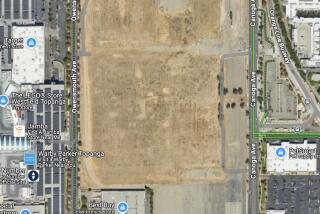Pollution Found at Site of Closed Plant in Santa Fe Springs
SANTA FE SPRINGS — Toxic wastes have seriously polluted ground water and soil beneath the closed Neville Chemical Co. plant, but the contamination has not yet affected drinking-water supplies, according to a six-month study of the site.
“It’s one of the more contaminated sites” in the state, said Richard Hume, project manager of the Neville site for the state Department of Health Services. “But just because there’s a lot of contamination doesn’t mean it’s necessary to make an immediate response. We don’t see any risk we would call imminent and substantial endangerment.”
The study is the latest development in the effort to clean up the Neville site, where the state has been investigating soil and water pollution for almost five years. Neville closed the plant in 1987 after 25 years of manufacturing chlorinated paraffin, a chemical used as a metal lubricant, flame retardant and in paint for traffic lanes. Dichlorobenzenes, dioxins and furans are among the byproducts of the chlorinated paraffin manufacturing process.
Concern Over Possible Migration
There was concern that some of these chemicals had migrated to Norwalk Manor, a 303-unit condominium development about 100 yards from the Neville site at 12800 Imperial Highway. However, soil tests showed no contamination.
Dichlorobenzene, a suspected cancer-causing agent, is present in the ground water beneath the plant at up to 1,400 parts per billion, a concentration more than 10 times the state limit for drinking water, the study concluded. The same chemical was found in the soil in concentrations of up to 29 million parts per billion, but the state has not established a limit on dichlorobenzene in the soil, Hume said. Excessive amounts of the carcinogens dioxin and furan also were found in the soil.
Dioxin and furan, chemicals that have caused cancer in laboratory animals, usually do not migrate from the surface, Hume said. But at the Neville site, dichlorobenzene is acting as a carrier for dioxin and furan and has plunged the chemicals to a depth of five feet, according to the study by James M. Montgomery Engineering Co.
The contamination is not considered an immediate threat because the ground-water table begins at about 100 feet and drinking water wells start at about 500 feet, Hume said.
“The real danger would be in finding dioxins in the ground water,” Hume said. “No dioxins are present now.”
The nearest well used for drinking water is about two miles away in the downtown Norwalk area and that well shows no sign of the chemicals polluting the Neville site, said Thomas Salzano, assistant general manager of the Central and West Basin Water Replenishment District.
Soil contamination, which has been detected at depths of up to 65 feet, is not a threat because the Neville site has been fenced off and paved, Hume said.
Investigators still do not know the extent of the ground-water contamination, which the study called “a potential threat to public health and the environment.” The most extensive ground-water pollution was beneath the Neville site, with less contamination farther from the plant, the study said.
Hume said more monitoring wells will be drilled during the next phase of the cleanup to to determine how far the dichlorobenzene plume has traveled.
First Disclosed in 1984
The pollution at the plant was first disclosed in 1984, when the Department of Health Services discovered the company had buried 21 drums of toxic wastes at the site. In 1986, Neville was convicted of federal charges of illegally disposing of hazardous wastes, and the government ordered the company to pay for the $2-million cleanup of the site and surrounding areas affected by the contamination. The state is spending $100,000 in federal Superfund money to oversee cleanup of the site, Hume said.
The first part of the cleanup was the six-month study that identified the extent of the contamination on the 3.5-acre Neville manufacturing site, an adjacent 1.6 acres leased by Neville, about one acre owned by the city of Santa Fe Springs, and the Norwalk Manor recreation area.
State Department of Health Services officials held a community forum a year ago at Norwalk City Hall to discuss the cleanup effort, and Hume said another forum probably will be held this spring once the state gives final approval to the first phase of study.
The second phase of the study, to be completed late this year, will include further study of the extent of ground-water contamination and proposals for how the soil and water should be cleaned up.
More to Read
Sign up for Essential California
The most important California stories and recommendations in your inbox every morning.
You may occasionally receive promotional content from the Los Angeles Times.










